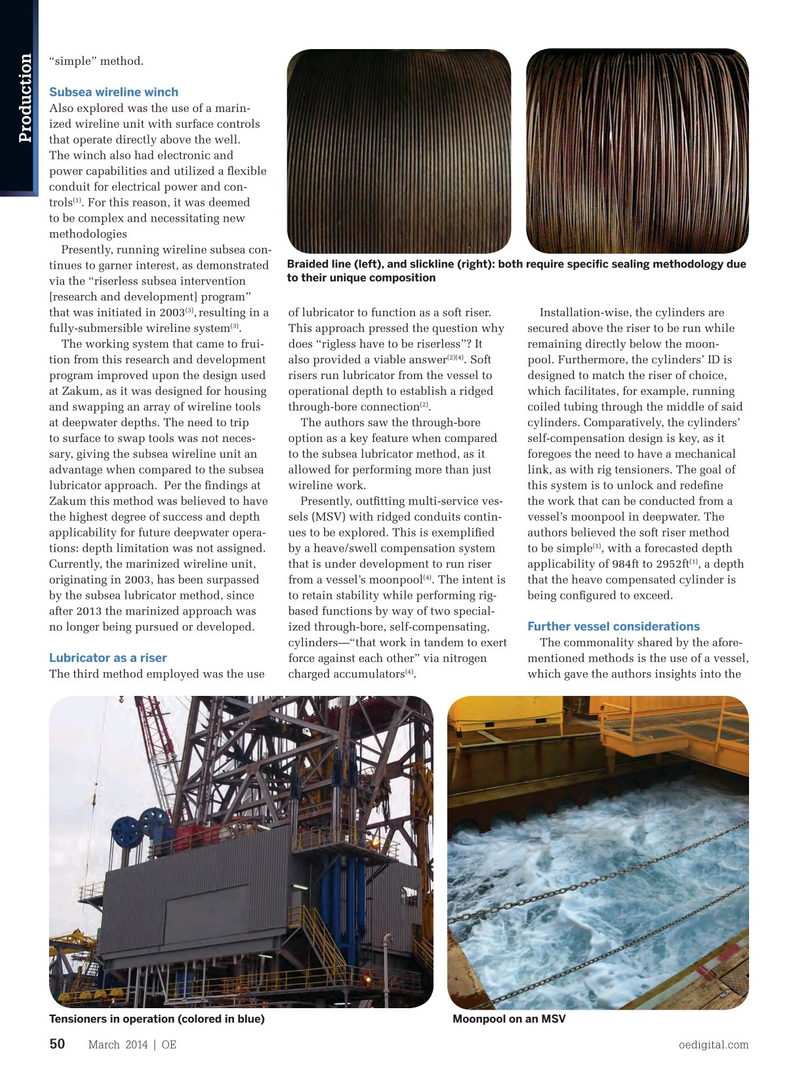
Page 48: of Offshore Engineer Magazine (Mar/Apr 2014)
Read this page in Pdf, Flash or Html5 edition of Mar/Apr 2014 Offshore Engineer Magazine
“simple” method.
Subsea wireline winch
Also explored was the use of a marin- ized wireline unit with surface controls
Production that operate directly above the well.
The winch also had electronic and power capabilities and utilized a fexible conduit for electrical power and con- (1) trols . For this reason, it was deemed to be complex and necessitating new methodologies
Presently, running wireline subsea con-
Braided line (left), and slickline (right): both require specifc sealing methodology due tinues to garner interest, as demonstrated to their unique composition via the “riserless subsea intervention [research and development] program” (3) that was initiated in 2003 ,resulting in a of lubricator to function as a soft riser. Installation-wise, the cylinders are (3) fully-submersible wireline system . This approach pressed the question why secured above the riser to be run while
The working system that came to frui- does “rigless have to be riserless”? It remaining directly below the moon- (2)(4) tion from this research and development also provided a viable answer . Soft pool. Furthermore, the cylinders’ ID is program improved upon the design used risers run lubricator from the vessel to designed to match the riser of choice, at Zakum, as it was designed for housing operational depth to establish a ridged which facilitates, for example, running (2) and swapping an array of wireline tools through-bore connection . coiled tubing through the middle of said at deepwater depths. The need to trip The authors saw the through-bore cylinders. Comparatively, the cylinders’ to surface to swap tools was not neces- option as a key feature when compared self-compensation design is key, as it sary, giving the subsea wireline unit an to the subsea lubricator method, as it foregoes the need to have a mechanical advantage when compared to the subsea allowed for performing more than just link, as with rig tensioners. The goal of lubricator approach. Per the fndings at wireline work. this system is to unlock and redefne
Zakum this method was believed to have Presently, outftting multi-service ves- the work that can be conducted from a the highest degree of success and depth sels (MSV) with ridged conduits contin- vessel’s moonpool in deepwater. The applicability for future deepwater opera- ues to be explored. This is exemplifed authors believed the soft riser method (1) tions: depth limitation was not assigned. by a heave/swell compensation system to be simple , with a forecasted depth (1)
Currently, the marinized wireline unit, that is under development to run riser applicability of 984ft to 2952ft , a depth (4) originating in 2003, has been surpassed from a vessel’s moonpool . The intent is that the heave compensated cylinder is by the subsea lubricator method, since to retain stability while performing rig- being confgured to exceed.
after 2013 the marinized approach was based functions by way of two special-
Further vessel considerations no longer being pursued or developed. ized through-bore, self-compensating, cylinders—“that work in tandem to exert The commonality shared by the afore-
Lubricator as a riser force against each other” via nitrogen mentioned methods is the use of a vessel, (4)
The third method employed was the use charged accumulators . which gave the authors insights into the
Tensioners in operation (colored in blue) Moonpool on an MSV
March 2014 | OE oedigital.com 50 000_OE0314 ProdOps2.indd 50 2/21/14 4:25 PM

 47
47

 49
49